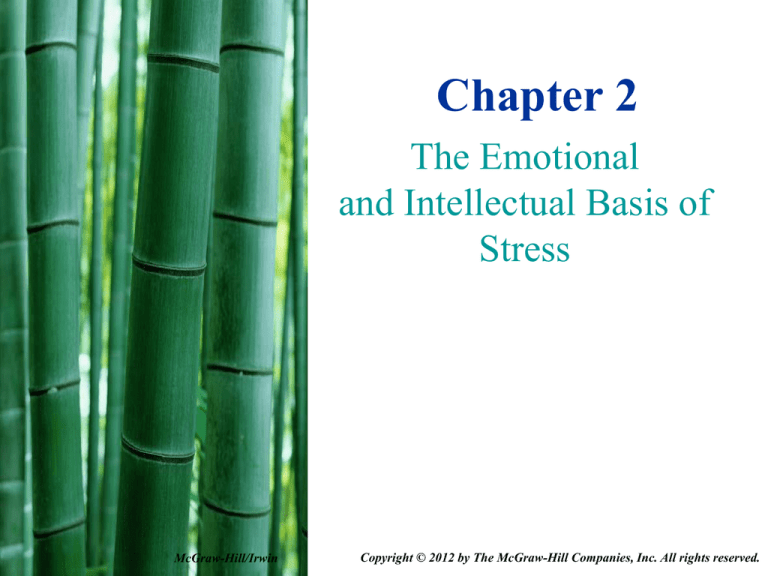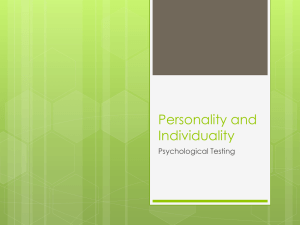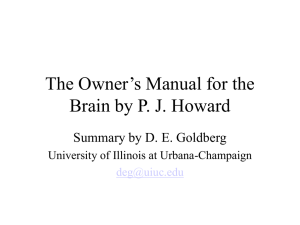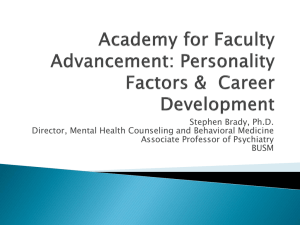
Chapter 2
The Emotional
and Intellectual Basis of
Stress
McGraw-Hill/Irwin
Copyright © 2012 by The McGraw-Hill Companies, Inc. All rights reserved.
Overview
This chapter
Examines relationship between emotions,
intelligence, and stress
Defines personality and how it develops
Examines ways some personality types are
more or less susceptible to stress than
others
Discusses the notion of emotional
intelligence
Presents a theory of stress appraisal that
converges intellectual and emotional
factors
2-2
Outline
Emotions and stress
Personality development and
types
Intelligence and stress
Emotional intelligence
Perception and stress
appraisal
2-3
The Emotional Basis of
Stress
Emotions and stress
Emotion: “a feeling, and its
distinctive thoughts,
psychological and biological
states, and range of propensities
to act” (Daniel Goleman)
Lazarus’ stress emotions
Core relational themes
(internalized personal scripts)
2-4
Emotions in Japanese
Psychotherapy
Morita therapy: the action element
of Japanese psychotherapy
Reynolds adapted Shomo Morita’s
five guiding principles of feelings
“Living Constructively” boxes
throughout the textbook focus on
Morita and Naikan (the
introspective element of) Japanese
psychology
2-5
Personality Defined
Personality: a collection of
thoughts, attitudes, values, beliefs,
perceptions, behaviors, and
emotions that define who we are,
how we view the world around us,
and how others perceive us
Personality is constantly evolving
2-6
Emotional
Development and
Personality
Personality development theories
Watson (behaviorism)
Freud (psychoanalytical theory)
Erikson (developmental stages and
tasks)
Piaget (cognitive development)
Kohlberg (moral development)
Maslow (hierarchy of needs)
2-7
Stress and
Personality
Stress-Prone Personality Types
Type A Personality
Type C Personality
Type D Personality
(Ellis’s) Irrational, Illogical
Personality
Negative Self-Talk
Millon’s Model
2-8
The Type A
Personality
Pioneered by cardiologists
Friedman and Rosenman (1974)
Noticed their cardiology
patients always tried to achieve
more in less time
Hypothesized this was stressful
and harmful to one’s heart
2-9
Characteristics of Type
A Personality
Competitive
Verbally aggressive
Hard-driving
Unable to relax
Very time conscious
Easily angered
Hostile
2-10
Type A Personality Body
Language and Speech
Patterns
Tightening of facial muscles
Gesturing with a clenched fist
Grimacing
Using explosive speech
Interrupting the interviewer
Hurrying the pace
2-11
Type A Personality
Health Risks
Greater rate of cardiovascular
disease
Greater rate of heart attacks
Increased risk for premature
death from all causes
Not gender-specific
2-12
Recent Type A Personality
Studies
Clarify earlier work
Suggest Type A personality not
a causative factor in high blood
pressure
Identify anger and hostility as
factors most closely related to
cardiovascular disease
2-13
Anger and Hostility
Anger
Directed at anything
Reaction to a specific situation
Road rage is a common form
Hostility
An enduring anger directed at
people
2-14
The Type C Personality
Identified by Temoshok and
Dreher
Described as ______-prone
personality
Responds to repeated failure
and stress by giving up
(helpless/hopeless)
Suppresses emotions and
resigns self to fate
2-15
The Type D Personality
Associated with cardiovascular
disease
Similar to Type A
Anger & hostility
Type D’s:
suppress their emotions
Avoid social contact
2-16
The Irrational, Illogical
Personality
Named by Albert Ellis
Founder of rational
emotive behavior therapy
(REBT)
Believes people or things
don’t make us feel bad
______ beliefs about people
and things are the basis for
stress
2-17
Categories of Ellis &
Harper’s 10 Illogical
Beliefs (Walen et al.)
“Awfulizing” statements—
Shoulds/musts/oughts—
Evaluation of worth statements—
Need statements—
2-18
Millon’s Model
Millon identified 8 personality styles
that are particularly prone to stress
Aggressive
Narcissistic
Histrionic
Dependent
Passive-Aggressive
Compulsive
Avoidant
Schizoid
2-19
Stress-Resistant Personality
Types
Personality types that are
protective against stress
The Type B Personality
The Hardy Personality
2-20
The Type B
Personality
Identified by Rosenman and Friedman as
polar opposite of Type A
Also known as non-Type A
Lower risk of heart disease when free
of diabetes, hypertension, and
elevated cholesterol
Doesn’t preclude success and
achievement
2-21
The Hardy
Personality
Identified by Kobasa and Maddi
Exhibits three personality traits that
protect against ravages of stress
Commitment (actively involved
with life)
Control (internal locus of control)
Challenge (welcomes change)
2-22
The Intellectual Basis of
Stress
Our “intellectual resources”
(Lazarus) influence
How we perceive potential
stressors
Our perceived ability to cope
Intellectual resources include
intelligence, life experience,
communication skills, creativity,
problem-solving ability
2-23
Emotional Intelligence
Goleman (1997) coined this term to
mean the intellectual attributes
associated with understanding and
managing emotions
We can exert some control over our
emotions, moods, temperament, and
emotional disorders
2-24
Five Criteria for
Emotional Intelligence
Knowing emotions
Managing emotions
Motivating oneself
Recognizing emotions in others
Handling relationships
2-25
Lazarus & Folkman’s
Stress Appraisal Model
The model contains a convergence
of intellectual and emotional factors
Things become stressors when they
threaten our well-being
Appraisal process influenced by
time and environment (context)
Appraisal process has three parts
2-26
Three Appraisal
Processes
Primary appraisal: Is it a
threat?
Secondary appraisal: Can I
cope with it?
Cognitive reappraisal: Is this
potential stressor a real
stressor?
2-27
Primary Threat Appraisal
Threat: state of anticipated
confrontation with a harmful
condition
Physical harm, emotional pain, or social
discomfort
Primary appraisal: Is it a threat?
Irrelevant
Benign/positive
Stress
Threat (harm or loss anticipated)
Harm/loss (assessing consequences of exposure)
Challenge (possible positive outcomes)
2-28
Situation Factors in Stress
Appraisal
The potential stressor
Novelty, predictability, event uncertainty
Imminence, duration, and temporal
uncertainty
Person Factors in Stress
Appraisal
Commitments
Beliefs (cognitive configurations)
2-29
Secondary Stress Appraisal
Can I cope with it?
Occurs simultaneously with primary
appraisal
Coping: Emotion-focused or problemfocused
Coping resources
Health and energy
Positive beliefs
Problem-solving skills
Social skills
Social support
Material resources
Situational constraints
2-30
Cognitive Reappraisal
Is this potential stressor a real
stressor?
Reassessing after weighing
all of the situational factors,
commitments and beliefs, and
assessing ability to cope
2-31
Chapter 2: The Emotional
and Intellectual Basis of
Stress
Summary
2-32










